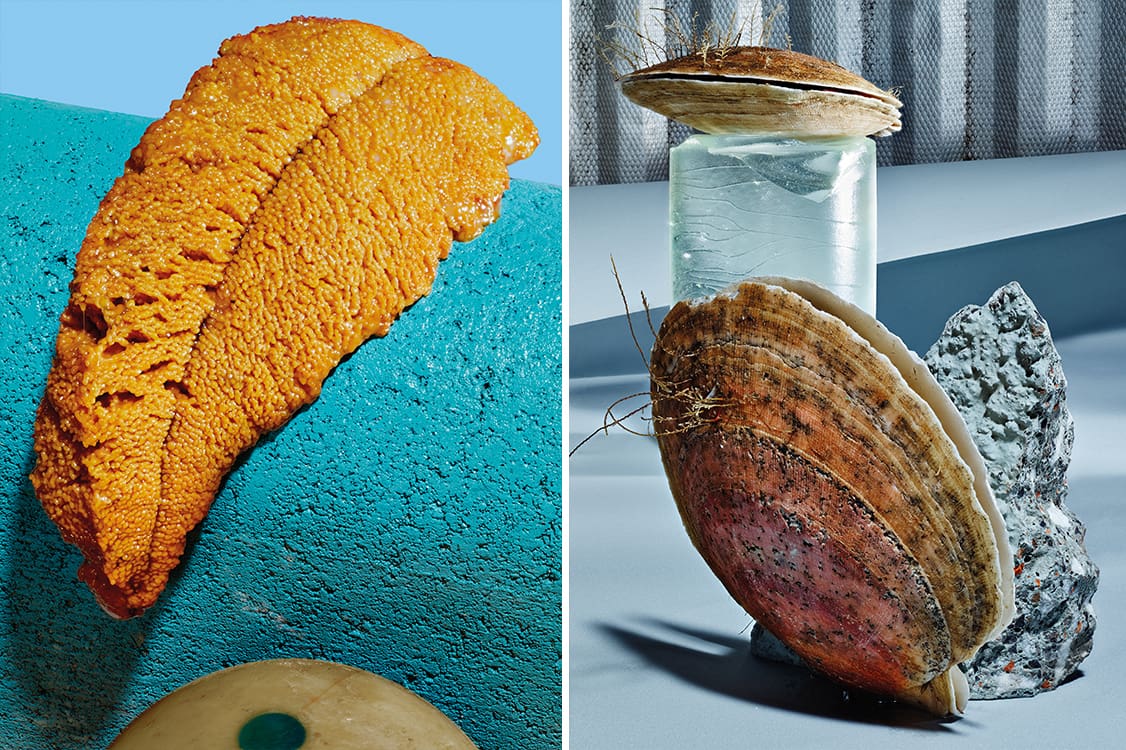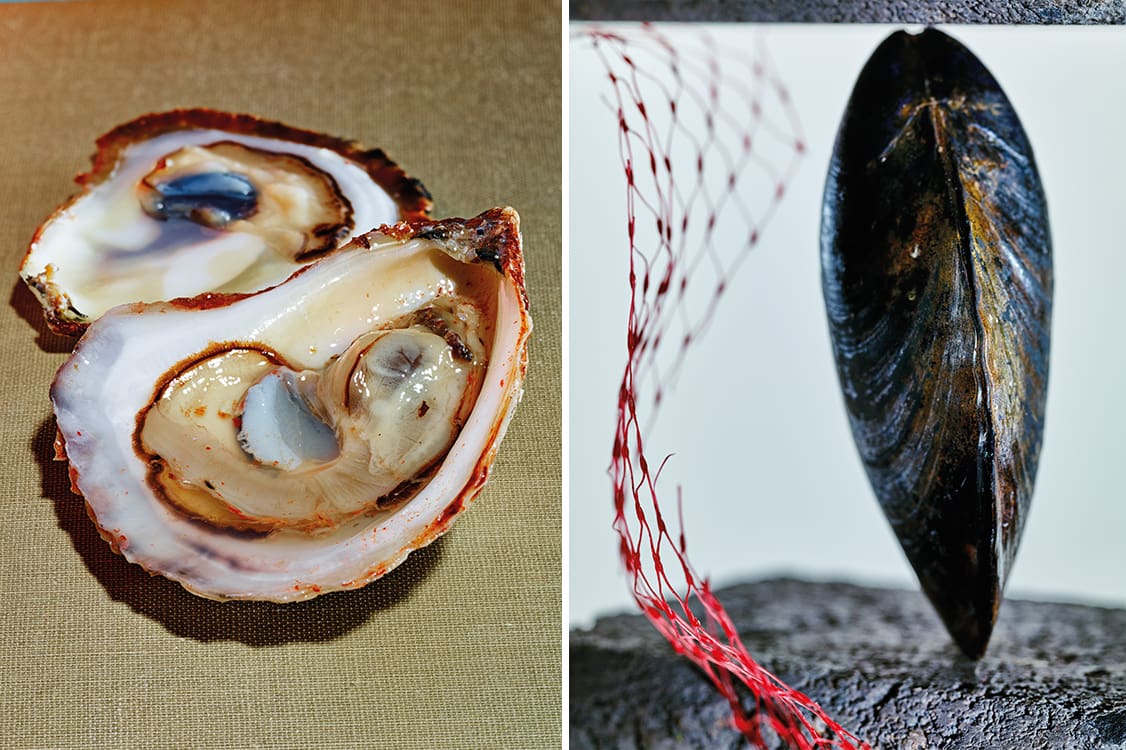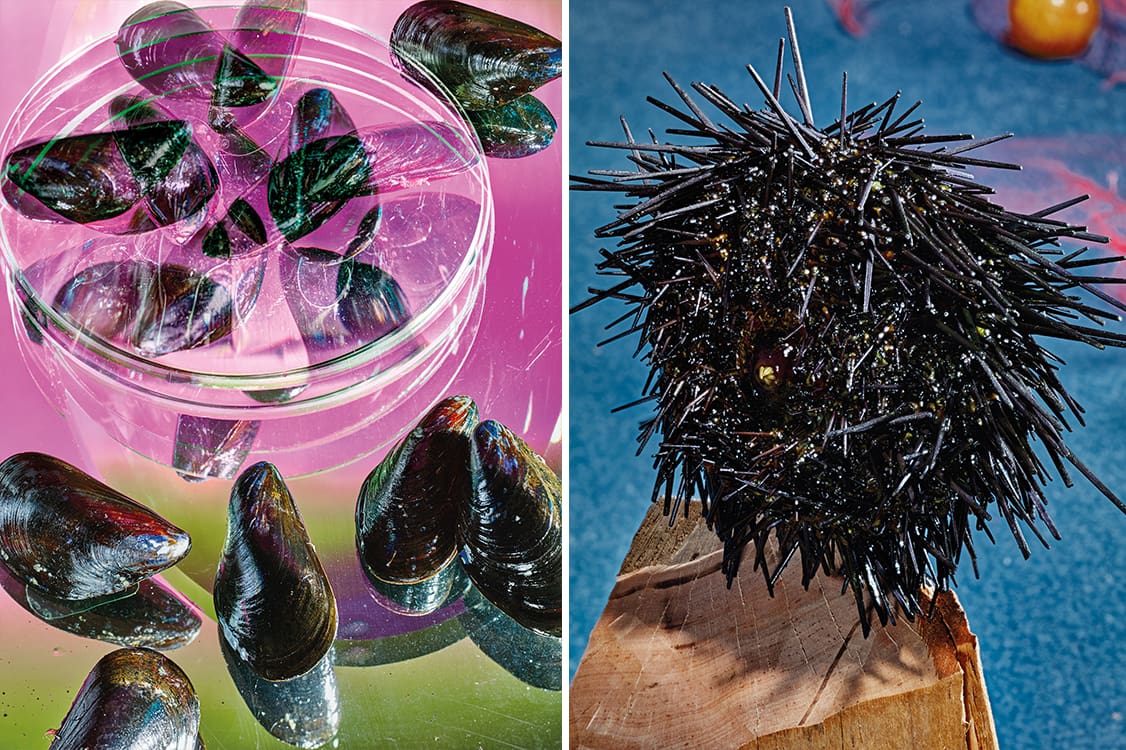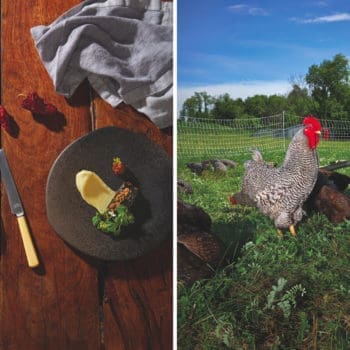by TARAJIA MORRELL
photography GRANT CORNETT
1.2
My infatuation with mollusks started early. My salad days were spent exploring a long jetty that extended out from a small stretch of beach that we could call our own. When I was old enough to need more entertainment than building a sandcastle could provide, my mother began our jetty lessons.
We’d walk south on the firm, fresh-licked sand, past the first, shorter jetty, past the eerie dilapidated Seaside Sanitarium, to the second stone walkway that extended above the dark waters. She taught me early to step-jump from boulder to boulder, leaving the land behind us as we ventured further out. She showed me how to lie on my belly and lean my torso down into the musty, low tide-exposed spaces between rocks, to pop seaweed between my fingers like bubble wrap and investigate the aquatic life below. These were the alcoves she’d grown up exploring, peering into their ragged crevices for starfish and snails; gingerly picking black Atlantic sea urchins and sideways darting crabs from small, wet chambers between the stones. And so I did the same.
We brought buckets to carry our plunder, and before it was time to bid adieu to my jetty-dwelling friends and return them to their crannies, I studied them obsessively, attempting to comprehend a life within a shell. Their armor made sense to me immediately: these hard, tight covers protecting the fragile collection of cells within … but then, where are our shells?
What I was too young to understand then was that we too were growing shells: firm, sometimes prickly, appendages to keep hungry hands from getting at our fragile parts: our deepest hopes, our hidden fears.
The personalities we construct, just like the mollusks’ shells, can be our camouflage, our refuge or our maquillage.
When I was six, a summer friend taught me to hum to snails to coax them out of their shells. “They feel the vibration,” she said. “It reminds them of the sea and so they feel safe and come out.”
This is where my thoughts go when I scrub mussels and with icy fingers tug at their stubborn beards. As I hold urchins—spines swaying slightly as their amber residue stains my pale hands—and as I cut into them and a wet, beady, bright, secret interior world of viscera is revealed. I think of the barricades I have grown to cope with the unpredictable: the loss of a friend; the pain of a lover who has taken leave; the doubt that has forced thorny defenses to safeguard my softest parts.
But even as the guards are developing and hardening, amid those secluded desires lies the longing to be pried open and adored. Because the most precious moments are the ones when our shells have been shed, when just the right alchemy of wit and heart and heat has disarmed us and persuaded us to disrobe. We yearn to feel safe enough to dismantle our spectacular artifices, and be both exposed and cherished in the subjection, when nimble fingers have opened us up.
Oh, how I long to be hummed to.
Coquilles Saint Jacques
I learned to cook from my mother, who is self-taught and often follows Julia Child’s oeuvre in the kitchen—her enthusiasm, exasperation and glee. This simple recipe, adapted from mastering the art of French cooking, defies the stodgy rule that seafood and cheese cannot go together. Coquilles Saint Jacques was a childhood staple for me, an early example of food’s fundamental relationship to the wine that is sipped with it. This dish is comforting, yet feels simultaneously sumptuous. Whether as an appetizer or a main course, a chablis, sancerre or pouilly-fumé will pair well. The white wine should be bracingly cold and the scallops enjoyed whilst piping hot!
Cathy Morrell, inspired by Julia Child
serves: 4 to 6
2 or 3 scallions, thinly sliced
2 tablespoons minced shallots
2 gloves garlic, minced
1 1/2 lbs sea scallops, washed and dried well (1/4 lb scallops per person) (680g)
salt and pepper
2 – 3 tablespoons sifted flour
3 tablespoons butter
1 tablespoon olive oil
2/3 cup dry white wine, such as a sauvignon blanc or chablis
small bay leaf (160ml)
1/8 teaspoon dried thyme
1/4 cup grated Gruyère (28g)
1 – Over low flame, sauté scallions and shallots in olive oil until tender but not browned, add the minced garlic and cook slowly for about one minute; set aside.
2 – Slice the scallops into 1/4 inch rounds. Put the scallop rounds in a plastic baggie, sprinkle with salt and pepper and with sifted flour; shake baggie until the scallops are well coated. Sauté the floured scallops quickly in hot butter and olive oil about 2 minutes. Add wine to the skillet. Add the herbs and scallion-shallot-garlic mixture. Cover the skillet and simmer about 3 – 4 minutes. The sauce should thicken slightly. Transfer into a broiler-proof au gratin pan (or individual scallop shells if you prefer.) Sprinkle 1/4 cup of grated gruyère and dot with a tablespoon or two of butter. Brown briefly under broiler and serve immediately.
Grilled Oysters
There’s nothing like oysters for making a Tuesday afternoon feel like an occasion. More often than not, I slurp mine raw with nothing more than a squirt of lemon juice, trying to memorize the natural notes. Lately, however, I’ve fallen in love with these warm ones from Danish chef Mads Refslund of Acme. The celery root juice and parsley oil brings a vegetal richness to their briny sea flavors, and the hot rock-bed on which they lay suggests all the sultry pleasures that oysters—whether hot or cold—unfailingly deliver. These oysters would be wonderful with a Muscadet
or Sauvignon Nlanc.
Mads Refslund, Acme
serves: 4 to 6
2 celery roots
3 apples
500g grape seed oil
100g parsley leaves
2 lemons, juice only
Sea salt
Oysters, up to 2 dozen of any deep-shelled varietal
1 – Juice celery roots and apples; keeping juices separate. Over a medium flame, reduce celery
root juice by a third. Sweeten with apple juice to taste. In a food processor or with an immersion
blender, blend the grape seed oil with parsley leaves (no stems) until oil starts to smoke.
Strain through a coffee filter.
2 – Put oysters on the grill; when they pop open they’re ready. Use a knife to cut the mussel so that they’re easy to eat. Spoon celery juice into each oyster, followed by drizzle of parsley oil and a few
drops of lemon juice. Finish with sea salt crushed between fingers to taste.
Mussels Yen Ta Fo
Every so often one is lucky enough to experience a film, a painting, a meal, which
recalibrates the entire spectrum of a perceived medium. Though i’d been eating tom yum koong soup, green curry and pad thai for years, Uncle Boons, the retro-eccentric Thai restaurant in NoLita, introduced me to Thai food for the first time. Ann Redding and Matt Danzer, the co-chef couple, have created a non-traditional menu based on authentic recipes with ingredients available in New York City. This stew is perfect for the cold weather—a bright, aromatic panacea for dark winters’ nights—and will pair well with an alsatian riesling.
Ann Redding & Matt Danzer, Uncle Boons
serves: 4 to 6
For the Fish Stock:
3 lbs fish bones & heads, roasted in oven for about 10 minutes (1.4 kg)
4 quarts water (3.8L)
1 onion, quartered
1/2 lb tomatoes, quartered (225g)
3 cloves garlic, crushed
4 oz cilantro root & stems (115g)
1 – Fish bones available inexpensively from fishmonger. Put all above in stockpot and bring to a boil. As soon as it comes to a boil, immediately reduce to a simmer. Skim any foam off the stock as it’s
simmering. Simmer for about 45 minutes. Strain stock through a chinois or sieve into a clean pot.
For the Yen Ta Fo Seasoning:
1 teaspoon white peppercorn, ground
1 tablespoon Golden Mountain soy sauce
3 tablespoons fish sauce
1/4 cup red bean curd (60g)
2 tablespoons pickled garlic water (from jar)
3 cloves pickled garlic, finely minced
1/2 cup Panich Siracha sauce (125ml)
2 tablespoons white vinegar
1 orange, zest & juice
1 teaspoon sugar
1 teaspoon salt
1/4 cup extra virgin olive oil (60ml)
2 tablespoons red & orange Thai bird chilies, sliced
1 – Combine all above in bowl & whisk well.
For the Mussels:
1/4 cup shallot, minced (25g)
2 lb mussels (900g)
1/2 cup white wine (125ml)
1/2 cup cilantro leaves (25g)
2 tablespoons crispy garlic (minced garlic that has been sautéed in oil until crispy & strained)
1 – Whisk Yen Ta Fo Seasoning into fish stock. Taste for seasoning. Set aside. In large pot, heat 3
tablespoons oil and add minced shallot. Sweat until shallots are translucent and add mussels. Add wine and cook down until reduced by half. Add enough Yen Ta Fo stock to come halfway up the mussels. Put lid on pot. Check after a few minutes to see if mussels have opened. Once all the mussels are open, turn off heat. Transfer mussels and broth into bowl. Garnish with cilantro leaves and crispy garlic.
Sea Urchin Bucatini
There are few ingredients more polarizing than uni. Those who dislike it bristle at
its mention; those who love it are utter gluttons for its subtle, golden glory.
I am of the latter group and admittedly it’s become a question I ask on the first date. I can’t imagine growing old with someone who doesn’t like uni. This recipe, which combines its lavish, sensual flavors with pungent garlic and black pepper, shows off the echinoderm’s creamy complexity. this is the rich man’s cacio e pepe. It will pair well with a ribolla, vinho verde or pinot grigio.
Zoë Feigenbaum
serves: 4 to 6
1 tray of uni
6 tablespoons of unsalted butter (85g)
1 box Italian pasta
1 clove of garlic finely chopped
1 grind of fresh ground pepper – medium grind
1 pinch of kosher salt
1 pinch of chili flake
A few glugs of heavy cream
1 – Let butter sit at room temperature until it is completely soft.
2 – In a bowl: Whisk the uni until it is as smashed up as possible. Add the butter and whisk enthusiastically. Chuck in the ingredients and whisk your heart out.
3 – Boil the bucatini following the directions on the box for al dente.
Drain well (you want them to be as dry as possible but don’t go nuts).
4 – In a sauté pan over medium/low heat add your uni compound. When it is a liquid and not a solid (it can be made ahead and chilled) add your pasta. Gently tong it around until it is coated. Add a little splash of heavy cream to bind everything into a sauce and add a little additional creaminess—careful though, it can overwhelm uni’s delicate taste. Coax up the heat to a simmer and then turn it down—let the sauce thicken but don’t cook for more then 5 minutes. Salt to taste.
5 – Plate with a liberal two grinds of black pepper and serve with a simple salad of bitter greens.














